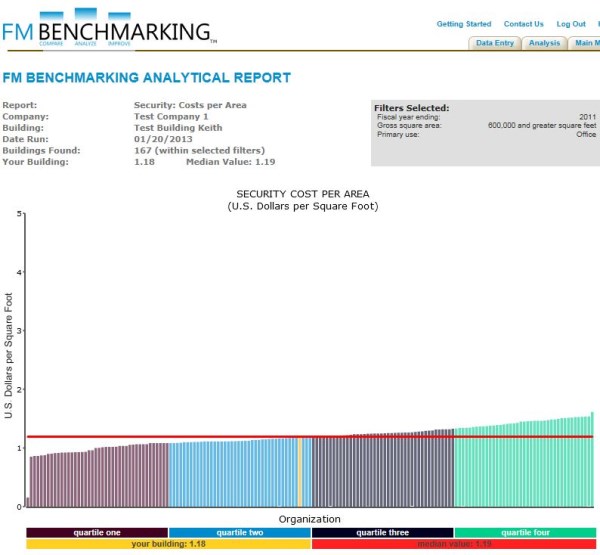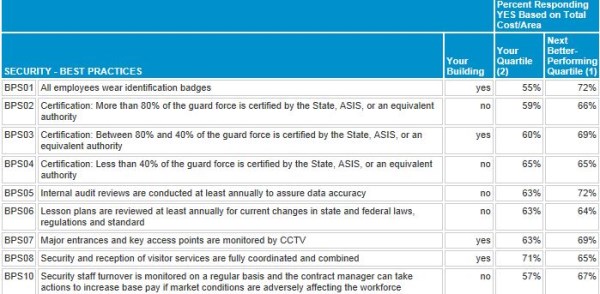Security contracts are an easy place for the organization to reduce. For security contractors can you easily show your security performance trends? Year after year you may be asked to cut expenses but most of your expenses are probably labor with very little materials.
Data entered in a benchmarking system can be used to document your improvements or even changes in service levels. Benchmarking is a straightforward process that can show the value of the Security function in the organization and what you have done over time. Without good benchmarking comparisons, you may not realize that security costs can be reduced, what security services others are using, or which best practices may have the most impact on improving your security operations. As you can see, a case easily can be made for benchmarking that will justify the minor amount of staff time.
We have used examples from FM BENCHMARKING to illustrate how easy the process should be; this type of approach will yield the key output reports in minimal time. In the following example, we benchmarked security performance and noted which “best practices” had been implemented in 2010. Then the benchmarking results were used to show areas for improvement; these in turn were used to justify implementation of other best practices that would improve the security operation.
Focus on the KPI (Key Performance Indicators) for the security metrics that need to be benchmarked:
- Security Cost per Gross Area
- Security Best Practices
The straightforward process will:
- Look at our benchmarked security costs for FY 2010.
- Determine which best practices we should implement in 2011.
- Implement the recommended best practices in 2011.
- Review our 2011 benchmarked costs to see how the implemented best practices affected our performance.
Figure 1 shows our security performance compared with our peer group of other office facilities. This allows you to see at a glance how our facility compares with other office buildings. There are 169 buildings in this peer group with a median security cost of $1.19 per square foot. Our building cost performance is in the fourth quartile with a security cost of $1.33 per gross square foot. Performance, from a cost perspective is not good so there are significant opportunities for improvement. By looking benchmarking data in this way and comparing similar types of facilities, you will be able to make intelligent “data driven” decisions.
First, note that the slope of the line is relatively flat. This tells us a little about the security functions in the benchmarked organization. With a few minor exceptions, all probably are paying a similar rate for their labor.

Filters: Type of facility (Office)
Let’s look at the best practices we have implemented and compare them to what others have implemented so we can generate some ideas that may improve our performance. We will use the cost performance data to see what others in our quartile and the next better performing quartile have done.
Figure 2 is a partial listing of the best practices implemented by those participants in our quartile and the next better performing quartile. There are actually more than 20 such best practices in the full table. After looking at just the first few we should consider recommending:
- BPS3 — Certification of more than 80% of the guard force. This shows a 15% jump in the implementation rate between the 4th and 3rd quartiles. Guard force certification is an effective measure of the quality of the staff performing the security services. Certification training also should build more loyalty in the workforce resulting in less staff turnover.
- BPS7 — Major entrances and key access points are monitored by CCTV. This shows an 18% jump in the implementation rate between the 4th and 3rd quartiles. This best practice has not been implemented, resulting in excessive security guard time to verify the condition of the access point. If the entrances were monitored, then fewer security guards could be utilized to control access to the facility.
- BPS8 — Security and reception of visitor services are fully coordinated and combined. This shows an 18% jump in the implementation rate between the 4th and 3rd quartiles. It seems obvious, but there are considerable cost savings, and negligible drawbacks, in coordinating these two functions.

Filters: Type of facility (Office)
So by looking at the more than 20 best practices a contractor can easily develop a program of top priority items that will reduce security costs for the client and improve the security quality. This gives us an excellent idea of the types of programs to implement in fiscal year 2011.
In this example, a facility located in Florida, USA, Senior Management and the contractor worked together to approve the funding and organizational changes to implement these best practices. The programs and changes were made and the contractor benchmarked their performance again in early 2012 for the calendar year ending 2011.
Figure 3 compares the security performance to other office facilities in the same manner as Figure 1 except that this is for 2011 instead of 2010. Note that we are now in the 2nd quartile (not the 4th) and our security costs have declined to $1.18 per GSF. This is a reduction of $0.18 per GSF over the entire building… quite an improvement! There are 167 buildings in this peer group with a median security cost of $1.19 per GSF so this is a very similar peer group compared to our 2010 benchmark.

Filters: Type of facility (Office)
Not only can we show significant improvement, but we have documented our initiatives in the “security best practices”. Note that in 2011 we implemented:
- BPS3 — Certification of more than 80% of the guard force.
- BPS7 — Major entrances and key access points are monitored by CCTV.
- BPS8 — Security and reception of visitor services are fully coordinated and combined.
Again the benchmarking data supported our decision to implement these best practices. The implementation rates are higher for buildings in the 2nd quartile (which is why they are doing better). This means a higher percentage of our peer group has also implemented these best practices. We are in good company with steadily improving performance.

Filters: Type of facility (Office)
Because benchmarking is a continuous improvement process, one should continue to look each year at these metrics and see if there are additional best practices that could be implemented to improve the metrics even further. For example, we note that one best practice that we had not yet implemented, BPS5 — Internal audit reviews are conducted at least annually to assure data accuracy, has 72% of those in the first quartile who have implemented it —- no other best practice has more. So we should consider implementing that next.
Conclusions
Using the results from benchmarking, the security contractor can make proven recommendations that will reduce security costs and improve security performance. The company achieved:
- Security cost savings by implementing the best practices recommendations.
- A higher quality and better performing security workforce.
- Improved levels of service or no degradation of service.